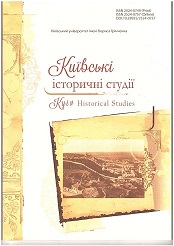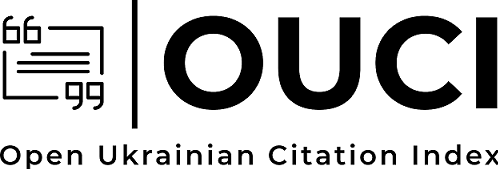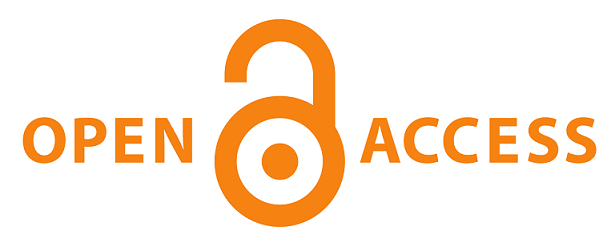MYKHAILO HRUSHEVSKYI AND OLEKSA NOVYTSKYI’S PARTICIPATION IN FORMATION OF UKRAINIAN INTELLIGENT NETWORKS
DOI:
https://doi.org/10.28925/2524-0757.2016.2.3Keywords:
intelligent network, M. Hrushevskyi, O. Novytskyi, correspondence, public organizations, Shevchenko studiesAbstract
The Ukrainians public and scientific life in the early 20th century, despite the constant pressure of the Russian Empire, was various enough. This is due to the interpersonal relations between Ukrainian scientists on both sides of the Russian-Austrian border. Among those who formed such intelligent networks and cultural field were future academicians of NAS of Ukraine Hrushevskyi and Oleksa Novitskyi. The source for the studying of their relationship is the correspondence, which is kept in the family archives of the Hrushevskyi in the Central State Historical Archive in Kyiv. Intelligent Networks are investigated using the following structure: ideology, organization, interpersonal contacts. Oleksa Novytskyi and Mykhailo Hrushevsky’s correspondence made it possible to activate the search and subsequent exhibition of Taras Shevchenko art works. In the orbit of this network the researchers of Shevchenko Scientific Society, the Ukrainians in Moscow and St. Petersburg, collectors were included. This made it possible to Oleksa Novytskyi to conduct Shevchenko exhibition in Moscow, to publish the fi rst a monograph on the poet’s artistic legacy “Taras Shevchenko as a painter.” Mykola Biliashivskyi, Mykhailo Hrushevskyi, Ahatanhel Krymskyi and other famous scientists helped Oleksa Novytskyi to collect the materials about Shevchenko. The collector K. Tsvitkovskyi in 1860 handed a copy of “Kobzar” with handwritten Shevchenko corrections, that were not included in the editions of 1907 and 1908s. Oleksa Novytskyi has repeatedly collaborated with Mykhailo Hrushevskyi within scientific societies. Oleksa Novytskyi published their researches in journals of Shevchenko Scientific Society, with the assistance of Mykhailo Hrushevskyi. The two scientists also worked within the Ukrainian Scientific Society that was established by Hrushevskyi in Kyiv. Oleksa Novytskyi was elected as a member of both academic institutions for his contribution to Ukrainian science. The article noted that Mykhailo Hrushevskyi invited Oleksa Novytskyi to cooperate in the journal “Ukraine”. An important consequence of the work of the Ukrainian scientist’s network and public officials was the intensification of Ukrainian community in Moscow and St. Petersburg. Oleksa Novytskyi participated in the creation of the Society of Slavic Culture in Moscow. However, the Ukrainian section of the Company was not active. Although there were such significant figures as K. Tsvitkovskyi, B. Kistiakivskyi, V. Vernadskyi, A. Krumskyi and M. Yanchuk. F. Korch, and Oleksa Novytskyi corresponded actively with Hrushevskyi about it. Oleksa Novytskyi subsection, organized with his eff orts, included scientific academician F. Korsch, B. Kistiakivskyi, M. Yanchuk, S. Khvostov, M. Filianskyi, O. Salikovskyi, S. Petliura. Organized eff orts informed M. Hrushevskyi and M.Bilyashivskyi about these events. Oleksa Novytskyi was chosen as the head of subsection and S. Petliura was chosen as its secretary. However, due to the workload of scientific and social work of members of the subsection, it could not expand their activity. Another structure of the Ukrainian community in Moscow, created by using active intelligence ties of Oleksa Novytskyi and other figures, was the circle “Kobzar”. Society managed to get permission in Moscow to stage the opera “Zaporozhets beyond the Danube” on the stage of the Bolshoi Theater for the first time. A good project that joined the forces of the Ukrainians in Moscow, Kyiv, Lviv, St. Petersburg was a monthly journal “Ukrainian Life”. Here Oleksa Novytskyi worked with Mykhailo Hrushevskyi. The decision of the publishing of the journal in Russian was adopted in October 1911 at the meeting of the Ukrainian section of the Society of Slavic culture. Therefore, Mykhailo Hrushevskyi and Oleksa Novytskyi cooperation in the early 20th century led to the expanding of Ukrainian intelligent networks and strengthening of the Ukrainian national identity. In the orbit of these networks Ukrainian scientists in Lviv, Kyiv, Moscow and St. Petersburg and collectors were included. It allowed finding and publishing a significant number of works of Kobzar, to hold Shevchenko exhibitions in Russia and to publish a significant number of Ukrainian studies. An important result of cooperation of Ukrainian scientists became the intensification of Ukrainian public activities in Moscow.
Downloads
References
Baskakov N.A. Akademik F.E. Korsh v pismakh sovremennikov / N.A. Baskakov, Nik.A. Baskakov. — M. : Nauka, 1989. — 286 s.
Bogdanov A.I. Fyodor Evgenevich Korsh / pod. red. Z.B. Mukhamedovoi / A.I. Bogdanov — Ashhabad : Ylym, 1982. — 126 s.
Vermenych Ya. Istoriia idey ta kryza istoryzmu / Ya. Vermenych // Eidos. — 2005. — № 1. — s. 24–27.
Dmitriev N.K. Fyodor Evgenevich Korsh / N.K. Dmitriev. — M. : Izd. Moskovskogo u-ta, 1962. — 36 s.
Ivanis V. Simon Petliura — prezident Ukrainy / V. Ivanis. — K. : B/v, 1993. — 267 s.
Instytut rukopysu Natsionalnoi biblioteky Ukrainy imeni V.I. Vernadskoho. — F. I. — № 12708. — Ark. 2; F. X. — № 31534. — Ark. 1; F. X. — № 32919. — Ark. 14, 17 zv.; F. 31. — № 1503. — Ark. 1–2; F. 31. — № 1504. — Ark. 1; F. 31. — № 1505. — Ark. 1; F. 31. — № 1508. — Ark. 1 zv.; F. 279. — № 1. — Ark. 6; F. 279. — № 16. — Ark. 1; F. 279. — № 802. — Ark. 1; F. 279. — № 1000. — Ark. 1.
Kolesnyk I. Hohol. Merezhi kulturno-intelektualnykh komunikatsii / I. Kolesnyk. — K., 2009. — 596 s.
Kolesnyk I. Kulturno-intelektualna istoriia yak dzerkalo «novoi naukovoi revoliutsii» / I. Kolesnyk // Eidos. — 2005. — № 1. — s. 36–45.
Matiash I. Pershyi holova bibliotechno-arkhivnoho viddilu (do 120-littia vid dnia narodzhennia O.S. Hrushevskoho) / I. Matiash // Studii z arkhivnoi spravy ta dokumentoznavstva. — 1997. — T. 2. — S. 104–110.
Novytskyi O.P. Varianty do «Kobzaria» 1860 r. / O. P. Novytskyi // Naukovi zapysky NTSh. — Lviv, 1911. — T. SP. — S. 157–162.
Novytskyi O. P. Kraievydy v poezii ta maliunkakh Shevchenka / O.P. Novytskyi // Siaivo. — 1914. — № 21. — S. 57–59; il.
Novytskyi O.P. Shevchenko yak maliar / O.P. Novytskyi // Literaturno-naukovyi visnyk. — Lviv, 1911. — T. IV.
Novytskyi O.P. Shevchenko yak khudozhnyk // O.P. Novytskyi / Nash zhurnal. — M., 1911. — № 4. — S. 42–46.
Putro O. «Trahichna smert yedynoho kozaka tysiachu novykh narodyt» (iz shchodennyka S. Yefremova za 1926 r.) / O. Putro, L. Portnova, L. Strelska // Ukrainska starovyna. — 1997. — № 5. — S. 111–126.
Rada. — 1911. — 12 liutoho.
Rada. — 1911. — 3 lystopada.
Rada. — 1912. — 28 sichnia.
Savytskyi R. Natkhnennyi spivak / R. Savytskyi // Suchasnist. — Miunkhen. — 1981. — № 7–8. — S. 184–190.
Slavinskyi M. Symon Petliura (1879–1926) / M. Slavinskyi / Zbirnyk pamiati Symona Petliury (1879–1926). — K. : MP “Feniks”, 1992. — 258 s.
Tsentralnyi derzhavnyi istorychnyi arkhiv u m. Kyievi. — F. 1235. — Op. 1. — Spr. 307. — Ark. 1 ; F. 1235. — Op. 1. — Spr. 556. — Ark. 7–8 ; F. 1235. — Op. 1. — Spr. 663. — Ark. 17.
Published
How to Cite
Issue
Section
License
Copyright (c) 2016 Kyiv Historical Studies

This work is licensed under a Creative Commons Attribution-NonCommercial-ShareAlike 4.0 International License.
Authors who publish in this journal retain the right of authorship of the work and give to the journal right of first publication of this work under the conditions of Creative Commons: Attribution-NonCommercial-ShareAlike 4.0 International (CC BY-NC-SA 4.0), which allows others freely distribute the work published with reference to the authors of the original work and the first publication of this magazine.














